Going Green
Smog? There’s an app for that
July 15, 2010
 Just think of it as sigalert.com for your lungs. What the South Coast Air Quality Management District bills as the nation’s first fully featured air quality app for smart phones is now available, free of charge and just in time for the worst of our region’s summer smog season. Enter a location and watch as a little map is bathed in the color corresponding to the air quality there. (In order of best to worst: green, yellow, orange, red or (gasp) purple.)
Just think of it as sigalert.com for your lungs. What the South Coast Air Quality Management District bills as the nation’s first fully featured air quality app for smart phones is now available, free of charge and just in time for the worst of our region’s summer smog season. Enter a location and watch as a little map is bathed in the color corresponding to the air quality there. (In order of best to worst: green, yellow, orange, red or (gasp) purple.)
It also has a cool calculator to determine your family’s carbon footprint, a locator for the nearest alternative fuel station and tips on what you can do to improve air quality. It even lets you drop a dime on polluting vehicles with a feature in which you can record and submit information on that smoke-spewing clunker in the next lane.
Last year, this region had more than 120 days of unhealthy air quality, and things are already on track for a similar number this year, with 46 unhealthy days reported so far, compared to 49 at the same time last year. The villain of the summer smog season is ground level ozone. One of the heroes just might be this app.
Watch a video on how it works here, and download from the Apple App Store.
County lands millions in federal green energy grants
April 22, 2010
Led by L.A. County officials, California’s clean and green energy programs got a major boost this week when Vice President Joseph Biden announced the list of 25 communities around the nation to receive a cut of the $452 million in American Reinvestment and Recovery Act funding to “ramp-up” energy efficiency building retrofits.
Rather than compete against each other for the federal funds, L.A. County and other parts of the state agreed to collaborate on their push for the money, a strategy that paid off handsomely. California collectively netted $30 million in new grant funding, of which $12 million will be dedicated exclusively to L.A. County. With funding from the Department of Energy’s ramp-up initiative, public agencies and private entities will soon launch neighborhood programs to rapidly expand energy retrofit projects, which can later be replicated at the state and national level.
Over the next few months, county officials will sit down with their federal counterparts and hammer out a detailed spending proposal, which will comprise a mix of direct financial incentives for retrofit projects like insulation, double-pane windows, heating and cooling systems and solar-power installations, as well as indirect investment in education, marketing and outreach programs.
And the $26 million county energy-efficiency grant applications that the California Energy Commission (CEC) turned down earlier this year? Not dead yet. County negotiators have been meeting with CEC officials in an effort to tap into other funding sources to keep County energy programs green and growing.
Posted 4/21/2010
No sunny skies for county’s solar grants
February 24, 2010
County officials are scrambling to regroup after the surprise denial of grants they were banking on to help launch a program for homeowners seeking affordable solar and other green-energy retrofits.
Under the program, property owners would repay loans for solar panels and other energy saving devices through an annual assessment on their property tax bills. Once launched, the county’s program would represent the largest of its kind for private property owners in the nation.
There would be no upfront cost to homeowners, who, depending on the extent of the retrofit, could save up to 30% on energy bills. Greater savings were anticipated from a state grant that would have cut interest rates by up to a full percentage point for initial participants.
But the California Energy Commission earlier this month rejected two grant applications from the county—one for $13.5 million to help lower homeowner borrowing costs and the other for $12.9 million to market the program throughout the county’s 88 cities. The commission said the county failed to meet the minimum score required for both applications.
The commission made a $4.7 million grant to the city of Los Angeles, but overall awarded nearly 95% of the available federal funding it administers through the State Energy Program to local governments in Northern California.
“Ultimately, not having these grants makes the program more expensive to property owners in L.A. County and makes it harder for us to promote it,” said Howard Choy, head of L.A. County’s clean-energy division in the Internal Services Department. Instead of taking part in a countywide promotional plan, individual cities will need to come up with ways to advertise the program to homeowners who live outside the county’s unincorporated areas.
The homeowner energy-efficiency loan program, if approved by the Board of Supervisors, is set to begin in August with seed money provided by approximately $12 million in American Recovery and Reinvestment Act (ARRA) funds. Eventually, bonds will be issued and investors repaid as homeowners pay off their retrofit loans.
A typical homeowner of a 2,000 square foot residence might invest $10,000 to $20,000 to upgrade a house by sealing leaks, changing out windows, upgrading the heating and air-conditioning system and purchasing new energy-efficient appliances. Such a whole-house energy retrofit could shave nearly a third off the annual energy bill, and even more if solar-panels are installed to generate additional electricity. (Estimate your home’s potential on the county’s solar map.)
If a homeowner sells the house before repaying the loan, the assessment—along with the improvements—would remain with the property. And that would remove a major reason why some property owners have shunned solar: a concern they’d be unable to recoup their initial investment before selling the property.
Although the California Energy Commission’s rejection of the county’s grants proposals is not fatal, it does present obstacles to getting the program off the ground—particularly by undermining the county’s ability to offer homeowners lower interest rates on energy-saving investments. County officials had hoped to entice public participation through those lower rates, which would have reduced the semi-annual property assessment and shortened the time needed to recoup the initial investment. Overall, the goal is to have the energy projects pay for themselves over the course of 20 years.
Choy said he was shocked by the funding shut-out. “We thought we had a very, very strong application representing a key region,” he said in an interview, noting that the county’s submission was prepared by the same consultants whose grant applications had been approved for other jurisdictions. “We are arranging with the [commission] to discuss the specifics of that scoring in a face-to-face briefing.”
The county’s program is part of a statewide effort formally known as Property Assessed Clean Energy (PACE), created in connection with the sweeping clean energy initiative authorized in 2008 under Assembly Bill 811.
Posted 2/24/10
From LEED to LID: A green-building primer
December 31, 2009
 New Year’s resolutions tend to fade by February, but Los Angeles County’s resolve to green-up home and commercial construction has the permanence and force of law.
New Year’s resolutions tend to fade by February, but Los Angeles County’s resolve to green-up home and commercial construction has the permanence and force of law.
On January 1, major elements of the green-building ordinance approved by the Board of Supervisors in 2008 go into effect, requiring new construction in unincorporated areas to be more sustainable and less polluting. Together with mandates that went into effect in 2009, the county’s new rules are among the nation’s most comprehensive, affecting projects from single-family homes to office high-rises.
The rules are complex and filled with language best understood by builders and planners. But the rest of us need not sit in the dark. So here’s a quick primer to shed a little (energy efficient) light on the subject:
• Upcoming projects will increase energy efficiency, cut greenhouse gas emissions, utilize sustainable construction materials and cut water use.
• Requirements govern both buildings and landscaping, but vary according to the size and type of the project.
• The ordinance requires builders to use LID, or Low-Impact Development, practices to save and recycle rainfall. Rather than shunting run-off to storm drains, the rules that went into effect in 2009 mandate the use of materials such as porous pavements. These let rainwater seep into the water table, thus increasing the drinking water supply while keeping dirty run-off away from our beaches.
• All commercial development must follow LEED, or Leadership in Energy and Environmental Design, building standards. Developed by the U.S. Green Building Council, LEED rules force builders to use efficient building methods and materials to reduce energy use, greenhouse gases and other pollution. Under the new restrictions, the bigger the project, the tougher the LEED standards. Small projects need only meet basic LEED benchmarks. Projects over 25,000 square feet have to follow LEED Silver standards. Residential projects with more than four units can choose between following LEED or two other stringent sets of standards.
• To slow the flow of construction debris to county landfills, builders must reuse or recycle at least half of the waste materials.
• Unlike other green building codes, L.A. County’s ordinance applies to single-family homes. For example, new homes must be 15 percent more energy-efficient than required by the prevailing state standards. Outdoors, the new codes limit the use of grass to 25 percent of a lot’s area and require the use of drought tolerant plants and low-flow irrigation.
High-profile projects that, if approved, are expected to seek building permits under the new rules include expansions at Pepperdine University and Universal City as well as a large residential development at Tejon Ranch.
A green holiday postscript
December 30, 2009
The Department of Public Works has posted a handy guide to Christmas tree recycling in communities across Los Angeles County. Strip off the lights, ornaments and tinsel and put that bad boy curbside on the day specified for your area.
The glitter days may be over, but the trees have one last role to play: most will be chipped up and turned into “alternative daily cover” in landfills, while the others will be transformed into mulch or compost. Last year, more than 350,000 Christmas trees were picked up as part of the recycling program run by the county’s sanitation districts. As for dealing with the rest of the seasonal excess—metallic wrapping paper, we’re talking to you now—check out the public works department’s tips for leaving a greener holiday footprint next year.
Blazing a new eco trail
October 27, 2009
You might think of them more as tree-savers than tree-huggers. But members of the Los Angeles County Fire Department are getting high marks for the eco-friendly landscaping at Station 65 in Agoura. And that’s just the beginning.
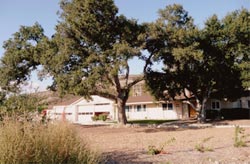
A California live oak surrounded by water-saving landscaping outside County Fire Station 65 in Agoura
The changes so far are subtle but important.
Grass has been replaced with artificial turf, organic mulch and rock ground cover in the new design, sketched out by Ronald M. Durbin, a deputy forester in the fire department’s Malibu Forestry Unit. There are roses around a memorial monument in front of the station, but the rest of the new planting emphasizes native plants, such as oak, sycamore and walnut trees as well as drought-tolerant ornamentals. The irrigation system is super-thrifty—with water directed at individual plants instead of spraying wide areas.
The new look caught the eye of the Las Virgenes Municipal Water District, which in June awarded the station its citizen of the month award. “Somebody did a good thing,” says Jeff Reinhardt, the district’s public affairs and communications manager. “You don’t have to have the lush green stuff, you know.”
The landscaping makeover is a small part of a bigger environmental push. Next up for station 65 and nearby station 67 are low-impact development retrofits—the first such makeovers to test-drive new water-saving, pollution-fighting requirements mandated for new development in the county. (Learn more about LID here.)
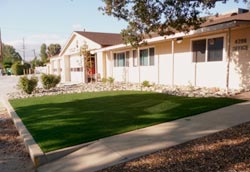 The goal of the program, essentially, is to keep rainwater from running off the property to replenish ground water supplies and, when possible, be reused for onsite irrigation. That means creating a new “bioswale planting area” and adding permeable paving, a planting area for gray water use, a cistern and even a rain barrel.
The goal of the program, essentially, is to keep rainwater from running off the property to replenish ground water supplies and, when possible, be reused for onsite irrigation. That means creating a new “bioswale planting area” and adding permeable paving, a planting area for gray water use, a cistern and even a rain barrel.
The LID improvements, to be funded with $872,000 in county funds appropriated under the leadership of Supervisor Zev Yaroslavsky, are expected to be approved by the Board of Supervisors on November 17 and should be in place by next year.
The Fire Department understands the need to be a positive environmental role model, says Durbin, who also has degrees in landscape architecture from Cal Poly Pomona.
“We’re in the public eye every day, so we need to set an example,” Durbin says.
That’s why the water district was eager to seize on the fire station as a public statement of water-thriftiness, done in an attractive way.
“It’s adjacent to the Paramount Ranch area but it’s also adjacent to some estate properties, and the folks who drive by there every day are going to see that,” Reinhardt says. “The statement it makes has got a lot of impact. It’s not only saving water but it blends more with the area. You’ve got this very water-wise projection into the community.”
Of course, as drought penalties for overuse kick in, the district also can get profligate users’ attention the old fashioned way. “About three weeks ago, we sent out a bill for $12,100 for a two-month billing cycle,” says Reinhardt of the Las Virgenes Municipal Water District. “The old model is just not sustainable.”
Going solar in SoCal
May 8, 2009
Los Angeles County has created an innovative, interactive “Solar Map” to help residents, business owners and public property managers quickly figure out how much money and energy they can save by switching to solar.
The new map covers more than 3,000 acres of territory, making it the largest of its kind in terms of geographic scope. Users simply enter their address and zip code, and the website automatically calculates how much electricity they can generate through roof-top solar panels, how much money they can save annually on utility bills and how much carbon dioxide emissions they can reduce every year.
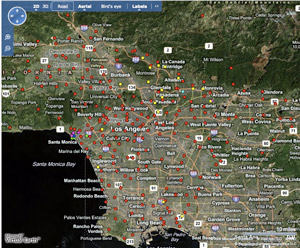 Los Angeles County’s solar map also gives people fast access to a list of licensed installers so they can get cost estimates and information about tax incentives and rebates in their neighborhoods.
Los Angeles County’s solar map also gives people fast access to a list of licensed installers so they can get cost estimates and information about tax incentives and rebates in their neighborhoods.
Existing incentives from utilities and the federal government offer up to a 62% discount for residential customers in the City of Los Angeles and up to 45% for Southern California Edison customers. With these incentives, the price of solar costs an average of between 10- and 15-cents per kilowatt hour—the amount of energy it takes to burn a 100 watt light bulb for 10 hours. That’s comparable to the cost of electricity purchased from Southern California Edison and the Department of Water and Power. Going solar will also help create a hedge against ever-rising utility costs since the cost of sunshine never goes up.
Solar power contractors will also benefit from the map’s detailed aerial pictures. They’ll no longer need to climb roofs to determine whether solar will work on a particular building. The site develops its estimate of solar capacity by measuring the roof’s pitch, orientation, shadow effects and architectural or structural elements that could reduce usable area.
Over time, contractor reliance on this technology is expected to help lower installation costs for all residents.
The Solar Map website was created through a partnership between the county’s Internal Services Department, Chief Information Office, CH2M HILL, Southern California Edison and several local cities. It cost a relatively small $93,500 by taking advantage of the County’s existing aerial imagery and applying new computer technology to get the desired information.
By creating a one-stop website for people interested in taking advantage of southern California’s solar-friendly climate, the website’s designers, who modeled Los Angeles County’s solar map after similar projects in San Francisco and other cities, hope it will help facilitate the burgeoning green power industry here, thereby reducing utility costs, fighting global warming and creating new green jobs.
As Supervisor Yaroslavsky put it during an April press conference to unveil the map: “Solar makes sense in Los Angeles and in Southern California” since “this is one of the capitols of sunshine on the globe.”




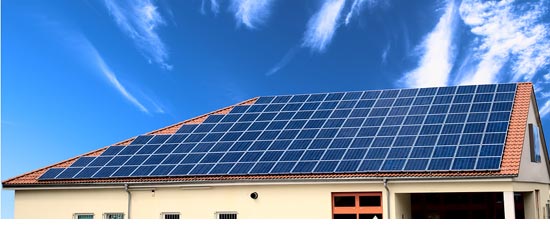
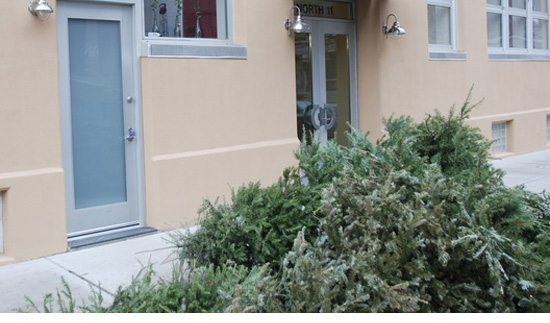







 405 bridge work causes a stink
405 bridge work causes a stink
